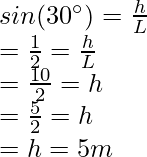位能练习题
在日常使用中,潜在的词被大量用于在其中表现出希望的事物或人。 “潜力”显示了采取行动的可能性。它给出了可以转换的存储能量的概念。这就是势能背后的想法。这个概念是力学的一个组成部分,允许我们从理论上测量物体内部存储的能量。势能可以来自任何力量。例如——拉伸或压缩的弹簧具有势能。坐在某个高度的物体由于高度而具有势能。
势能
势能是物体由于其位置或配置而拥有的能量。据说这种能量存储在物体内部。通常,势能是由物体通过运动释放的。例如,拉伸的弹簧在释放时开始向其自然位置移动并开始获得速度。由于这个速度,它获得了动能。为了进一步理解这一点,让我们考虑一个质量为“m”的球。

最初在地面上的这个球被带到“h”的高度。重力形式的外力作用在它上面。我们知道力 F 对物体位移“s”所做的功由下式给出:
W = Fs
在这种情况下,力是重力和从地面到高度“h”的位移。
F = 毫克,s = h
那么,重力对物体所做的功是,
W = -mgh
势能定义为这项工作的负值。表示势能 V(h)。
V(h) = mgh
如果球掉下来,在这种情况下,势能会减少,速度会增加。这意味着物体的势能正在转化为动能。假设球在触地之前的速度是“v”。
春天的势能
当弹簧保持正常时,称其能量为0,称其处于平衡状态。当它被拉伸或压缩时,并且有一定的位移,比如 x,它会在其中保存一定的势能,如下所示,
PE= 1/2 (Kx 2 )
其中,K = 弹簧常数
x = 由于压缩或膨胀引起的位移。
让我们看看基于这些概念的一些问题。
示例问题
问题1:从地面取2Kg的质量到10m的高度。求物体的势能。
回答:
The potential energy of a mass ‘m’ at the height ‘h’ is given by,
P = mgh
Given: m = 2kg and g = 10 m/s2 and h = 10m.
Aim: Find the potential energy.
Plugging in the values in the formula.
P = mgh
⇒ P = (2)(10)(10)
⇒P = 200J
Thus, the potential energy of the object is 200J.
问题2:从地面到100m的高度取5Kg的质量。求物体的势能。
回答:
The potential energy of a mass ‘m’ at the height ‘h’ is given by,
P = mgh
Given: m = 5kg amd g = 10 m/s2 and h = 100m.
Aim: Find the potential energy.
Plugging in the values in the formula.
P = mgh
⇒ P = (5)(10)(100)
⇒P = 5000J
Thus, the potential energy of the object is 5000J.
问题 3:从地面取出一块 5Kg 的质量,在楔子上上坡 5m。楔子与地面成 30° 角。求块的势能。
回答:
The potential energy of a mass ‘m’ at the height ‘h’ is given by,
P = mgh
This wedge is in the form of a right-angled triangle.
Figure
Let’s say, h is the vertical height at which the box reaches, let the slanted length be L
L = 5 m
Given: m = 5kg and g = 10 m/s2 and h = 2.5m.
Aim: Find the potential energy.
Plugging in the values in the formula.
P = mgh
⇒ P = (5)(10)(2.5)
⇒P = 125J
Thus, the potential energy of the object is 125J.
问题 4:从地面上取一块 10Kg 的质量,在楔子上上坡 10m。楔子与地面成 30° 角。求块的势能。
回答:
The potential energy of a mass ‘m’ at the height ‘h’ is given by,
P = mgh
This wedge is in the form of a right-angled triangle.
Figure
Let’s say, h is the vertical height at which the box reaches, let the slanted length be L
L = 10m

Given: m = 5kg and g = 10 m/s2 and h = 5 m.
Aim: Find the potential energy.
Plugging in the values in the formula.
P = mgh
⇒ P = (5)(10)(5)
⇒P = 250J
Thus, the potential energy of the object is 250J.
问题 5:求球在落地前的动能。假设最初,球的高度为 10m,质量为 2Kg。
回答:
Initially, at the height of 10m, the ball possesses potential energy. When it is dropped, it starts going towards the ground and its height starts decreasing. With decreasing height, velocity increases, and it acquires kinetic energy.
Potential Energy at t = 0
Potential energy will be given by,
P = mgh
m = 2Kg, h = 10m and g = 10 m/s2
P = mgh
⇒ P = (2)(10)(10)
⇒P = 200J
When the ball is about to hit the ground, it’s potential energy has become zero and all the energy is converted into kinetic energy.
Thus, K.E = 200J
问题 6:求球在触地前的速度。假设最初,球的高度为 100m,质量为 4Kg。
回答:
Initially, at the height of 10m, the ball possesses potential energy. When it is dropped, it starts going towards the ground and its height starts decreasing. With decreasing height, velocity increases, and it acquires kinetic energy.
Potential Energy at t = 0
Potential energy will be given by,
P = mgh
m = 4Kg, h = 100m and g = 10 m/s2
P = mgh
⇒ P = (4)(100)(10)
⇒P = 4000J
When the ball is about to hit the ground, its potential energy has become zero and all the energy is converted into kinetic energy.
Thus, K.E = 4000J
The formula for K.E is,
K.E =
m = 4Kg and v = ?. Plugging the values in the formula
K.E =
⇒ 4000 = ![]()
⇒2000 = v2
⇒ v = 10√20 m/s
⇒ v = 20√5 m/s
问题7:球从一定高度落到地面上,其全部势能转化为动能。最初放置球的高度为10m。球的质量为 1 公斤。找到动能的增益。
解决方案:
Since, the all the potential energy present in the ball is transferred into its kinetic energy,
Potential energy of the ball = Final gain in the kinetic energy
P= mgh
m= 1kg, h= 10m, g= 9.8m/sec2
P= 1× 10× 9.8
P= 98 Joule
Therefore, the final gain in kinetic energy is 98 Joules.
K.E= 98 Joule.
问题8:解释势能的存在,
一种。由于其地位
湾。由于对象所处的状态。
回答:
Potential energy can actually be present in two different cases,
a. Due to its position
Suppose an object is stable on the ground, now by applying some energy, it is taken at a certain height. The object present at a certain height will have energy saved in the form of potential energy. It is given as,
P.E= mgh
b. Due to the state in which object is present.
When a spring is kept in normal state, it is said to have 0 energy, but when the same spring is either compressed or stretched, it obtains potential energy which is given as,
P.E. = 1/2 (Kx2)
Where, x= displacement, K= Spring constant.
问题9:弹簧被拉伸到9cm,弹簧的弹簧常数为2 N/m。找出储存在弹簧中的势能值?
解决方案:
The potential energy stored in a spring is given as,
P.E= 1/2 (Kx2)
K= 2 N/m, x= 9cm= 0.09m
P.E= 1/2 (2× (0.09)2)
P.E= 8.1 × 10-3 Joules.
问题 10:两个物体保持在不同的高度,第一个物体在 5 米处,第二个物体放置在 15 米处。如果第一个物体比第二个重 5 倍,哪个物体的势能更大?
解决方案:
Object 1:
Height= 5 m, Mass= 5 m
P.E1 = 5 m× 5× 9.8
P.E1 = 245m Joules.
Object 2:
Height= 15 m, Mass= m
P.E2 = 15× m× 9.8
P.E2= 147m Joules.
Therefore, even when the first object is kept at lesser height, due to its weight, the first object has more potential energy.